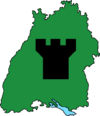Schloss Wolfegg
| Schloss Wolfegg | |
|---|---|
| File:Wolfegg-1765.jpg
Schloss Wolfegg with parish church (2013)
|
|
|
Location within Baden-Württemberg
|
|
| General information | |
| Architectural style | Renaissance |
| Classification | Kulturdenkmal (Cultural property) |
| Town or city | Wolfegg, Baden-Württemberg |
| Country | Germany |
| Coordinates | Lua error in package.lua at line 80: module 'strict' not found. |
| Construction started | 16th century |
| Completed | 19th century |
| Owner | Prince Johannes zu Waldburg-Wolfegg und Waldsee |
| Website | |
| Schloss Wolfegg (in German) | |
Schloss Wolfegg is a Renaissance castle next to the town of Wolfegg in Upper Swabia (Germany). The castle is the ancestral seat of the house of Waldburg-Wolfegg, which still owns it today.
Contents
Building
The main building of the castle consists of four wings arranged in the shape of a rectangle with towers in the corners. Its exterior design and layout dates back to Truchsess Jakob II. of Waldburg (1546–1589) and his wife Johanna (1548-1613). After a fire in 1578 destroyed an older building, they built a new castle. Parts of it however were destroyed in 1646, when Swedish troops under Carl Gustaf Wrangel ransacked the place near the end of the Thirty Years' War and laid fire to it.
Since the owner Maximilian Willibald of Waldburg-Wolfegg was short of funds, the restoration of the castle was delayed until 1651. From 1691 to 1700 the sculptor and plasterer Balthasar Kimmer of Wangen (1653–1702) redesigned the interior of the rooms with official and representative functions. In the 18th century some of the guest rooms were decorated in Rococo style. Towards the end of the 19th century the castle was extensively renovated again. The dining rooms received a new interior design and the castle's chapel was remodeled in a Neo-Gothic fashion.[1][2]
Utilization
The castle, which is still occupied by members of the Waldburg-Wolfegg family, is usually not accessible to the public. However once or twice a year public concerts are performed within the castle during which concert visitors can see some of the castle's inner room, in particular the Rittersaal (knights' hall). The Rittersaal is a large hall decorated in Baroque style featuring 24 life-sized wood sculptures and large ceiling mirrors. It is considered to be one of the most original room designs of the Baroque period in Germany. In addition to those rooms being used for concerts guided tours through other parts of the castle might be offered at that occasion.[1][4]
The castle also hosts the Wolfegger Kabinett, a large collection of graphic art from the late Middle Ages and the Renaissance periods.[2]
Discovery of the certificate that named America
In an edition of 1,000 issues the wall map of the world by the German cartographers Martin Waldseemüller and Matthias Ringmann was printed in early 16th century, where the continent and the name America appeared for the first time, originally published in April 1507.[5] On account of the stormy development of the cartography in this epoche these specimens were fast outstripped by more detailed editions, so that the original edition fell quickly out of use and all issues got lost over time.[6]
Their fate and whereabouts were unknown for a long time until one of the originals was rediscovered in 1901 by the historian and cartographer Joseph Fischer in the library of the castle, the Wolfegger Kabinett. The exemplar was 8 feet (2.4 m) wide and 4.5 feet (1.4 m) high and in a very good condition.[6] It was at first in the individual property of Johannes Schöner, who was an astronomer, geographer, and cartographer in the Free Imperial City of Nuremberg. Later the family of Waldburg-Wolfegg acquired the map and it remained in their archives for more than 250 years undiscerned.[7] In 2001 the United States Library of Congress bought the map from Waldburg-Wolfegg family for ten million dollars.[8]
See also
| Wikimedia Commons has media related to: Lua error in package.lua at line 80: module 'strict' not found. |
Notes
- ↑ 1.0 1.1 Schloss Wolfegg at the official websites of the town of Wolfegg (in German, retrieved 22 December 2012)
- ↑ 2.0 2.1 Lisa Zeitz: Großer Kleiner Klebeband. Arsprototo, Ausgabe 4/2011 (in German)
- ↑ Lua error in package.lua at line 80: module 'strict' not found.
- ↑ Andrea Reidt, Werner Sonntag: Allgäu. Marco Polo Reiseführer (Dumont) 2005, ISBN 3-8297-0283-3, S. 38 (in German, online copy, p. 38, at Google Books)
- ↑ Lua error in package.lua at line 80: module 'strict' not found.
- ↑ 6.0 6.1 Lua error in package.lua at line 80: module 'strict' not found.
- ↑ Lua error in package.lua at line 80: module 'strict' not found.
- ↑ Lua error in package.lua at line 80: module 'strict' not found.
Lua error in package.lua at line 80: module 'strict' not found.


